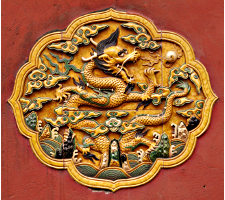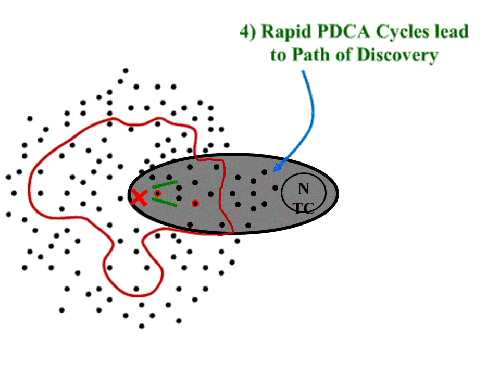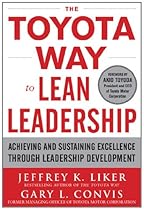One of the advantages of having a business performance blog is I have a ready place to rant complain share my customer experiences with the air travel industry.
It all started Monday. I had a flight from Seattle to Raleigh-Durham NC, connecting in Newark. It was only a two day trip, so I was traveling pretty light.
As we were boarding the 737 the bins filled up fast and everyone forward of about Row 15 was required to check their bags all the way to the destination. “We apologize for the inconvenience” (after pointing out how it was the customers’ fault because they had offered a chance for people to volunteer to check their bags, and not enough people did.)
OK, I checked my bag through to RDU. (Forshadowing)
Once on board, the pilot let us know that there were air traffic control delays enroute, but we were going to pull away from the gate anyway, and park on the tarmac until cleared. (This, by the way, lets them get credit for an on-time departure.)
That wasn’t too bad, only about 10 minutes. “We apologize for the delay.”
As we got to about the Great Lakes, the plane banks left. And banks. And banks. The shadow is gliding over the engine cowling, and returns to its previous position, the plane levels off. Yup, we just did what they call a “racetrack.”
Then we do another.
And another.
And some more.
We land at precisely the time my connecting flight is scheduled to depart. Not gonna make it. “There will be an agent waiting at the gate. We apologize for the inconvenience.”
Well – maybe everything is delayed, and I can still make the connecting flight. It wouldn’t be the first time I have lucked out that way.
Nope. Well, not quite. It hasn’t left because the plane never left RDU. Flight cancelled. “Head down to Customer Service at Gate 105.”
Wait in line, pretty surprised actually. Rebooked on a 7:32 flight, delayed to 9:51. Ugh. Got a few hours in the airport. “What about my luggage?” “It will be on the plane with you,” I was assured. More foreshadowing.
9:51 comes and goes. No plane. We’re told the inbound plane is enroute. OK.
I am having a nice chat with the pilot for our eventual flight to RDU. He is actually quite interested in the TPS. “Can you do this with airlines?” he asks, half seriously. He asks for a card. I know enough about aviation to have a very articulate conversation with a pilot about planes, flying, and the business, so that was nice. “No, I am not a pilot,” I answer his question, “but working at Boeing Flight Test for five years, you learn a thing or two about how airplanes work. I know what all the noises are.” He smiles.
Woo hoo. A plane shows up. Bombardier –8 Q400. We board.
And wait.
And wait.
11:15pm The (other) pilot gets on the P.A. and explains that they are overweight and working on how to handle it. He goes on to explain that due to the fog earlier in RDU, they have extra fuel on board. Further, the alternate airport is back at Newark. (Which means they need enough fuel for a round trip PLUS the reserve.) We wait. 11:45. A passenger (two, actually) volunteer on their own to be “bumped” to a flight tomorrow. Apparently that “solves the problem.” But the pilot had mentioned that part of the excessive load was “excess baggage from an earlier flight.”
“We apologize for the delay.”
“We are just as frustrated as you are.”
I should mention at this point one of the games that gets played here. By declaring the departure airport as the alternate airport, the airline can either land the plane at RDU with enough fuel for the return trip, or return it all the way to Newark and avoid a deadhead ferry flight from an alternate landing if they can’t make it into RDU.
At midnight the propeller begins to turn.
It is about a 90 minute flight.
I glance out the window and notice the propeller spinner is now white at the tip. Leading edge of the wing also turning white. In my brain fogged state I start thinking about this airline’s last accident.
We land at RDU at 1:40 or so. The airport is pretty much buttoned up except for us.
Head down to baggage claim. A few bags come out, then the sign flashes from “unloading” to “completed.” There are twenty people still waiting.
I was one of them. It seems that a lot of the passengers on the plane were the ones whose baggage was left behind because it was just bags from an earlier flight.
Our little cluster heads over to the airline’s baggage office. There are two people there, and it clear from their body language (and verbal language for that matter) that this was not in their plans for the evening. We customers with no baggage have, apparently, really inconvenienced them.
It turns out that, of the two, only one of them “can operate the computer.” so they are processing one person at a time, with a cycle time of roughly 10 minutes per person.
The non-computer one comes out. People ask her when they can expect their luggage to get here. She, in an annoyed “I already-told-you-I-can’t-do-anything” tone carefully explains that only her computer-literate co-worker can find out, and only when they scan the ticket and search for things on the computer.
She asks if we would like the 800 number. Sure. She goes into the office and comes out with the number written on a scrap of paper and reads it off while people try to type it into their phones. (Tape it up on the window? Nah.)
I manage to get through, “All of our representatives are currently serving other customers.” (Yes, I can actually SEE them right now.) “The wait time is approximately TWENTY minutes.” I am reminded multiple times that all I need to do is go to www.(Houston based airline name).com, click here, click there, enter this, enter that, and I can do all of this myself. Not exactly helpful in an airport terminal at 2:15am.
A human answers. She asks for my case number. Huh? I have the baggage claim number. It seems she is actually there to handle follow-up rather than initial calls. Nevertheless, she is very helpful, takes my information, and offers to authorize me to spend $75 if I need to buy something for my client meeting in the morning. “Thank you,” I say sincerely, and laugh with her that there isn’t a lot I can buy at 2:30 in the morning.
Head for the rental car counter. I still have a 90 minute drive ahead of me.
The only thing in the “Emerald Aisle” is a big pickup truck. I don’t feel like taking it, so I go into the office. A very nice gentleman at the National counter is surprised about the number of people showing up all of a sudden, I explain a late arrival. He asks if I want an SUV, I said sure, he tells me where it is.
I get in, start it up, punch in my hotel address into my phone (I LOVE Android GPS), and start out. Once I clear the gate, there is a 20 mph speed limit, and one of those radar signs that says how fast you are going. I see the sign, and immediately slow down. My speedometer is dropping down under 40, as the radar sign is dropping down under 20. Huh? Take a good look through the foggy brain. Kilometers Per Hour. Yup. I have a Canadian vehicle. So driving through rural North Carolina having to run metric conversion in my head. No big deal, but the final irony.
I arrive at the hotel at 4:30. The night clerk is on the phone, “Just a minute sir, they are doing an night audit.” I mention that I have been on the road for 22 hours. She takes the hint and interrupts the auditor to check me in.
4:45, I get to the room, take a shower, and settle down for my 75 minute nap before meeting my client in the lobby at 7am for a great day on site.
Good news – the suitcase showed up the next day.
Of all of the places that I have “gotten ahead of my luggage” this was actually the least exotic. The last three were Berlin, Glasgow and Tunis. Danville, VA just doesn’t seem that exciting by comparison.
So this was 20 hours of hearing airline employees begin every other statement with “we apologize.” (Except the baggage claim people who were quite UNapologetic). I suppose this was catching up with the law of averages for a series of very smooth and uneventful travel adventures lately.
What if a key airline performance metric was how many times their employees use the words “we apologize” during a given day? If they actually meant it, the number should steadily decline.

Hopefully the flight home will be less of an adventure.
All humor aside, this experience revealed a couple of obvious breakdown points.
First, I normally try to avoid any connection in the NYC area. The airspace is just too crowded for things to work under less than ideal conditions. But faced with the client’s requirement to use their travel booking, and unable to gerrymander arrival / departure times to force a decent fare-competitive alternative out of the system, I kinda had to take this one.
Let’s talk about the baggage thing. At the departure airport, we have the aircraft service process that loads fuel, calculates weights, generally gets the plane ready for a safe flight within regulatory guidelines (and consistent with airline economic objectives).
We have a separate process that takes luggage with “RDU” tags and loads them onto a plane headed for RDU.
And yet another process for getting the passengers manifested and loaded.
I surmise that there are three separate processes here because there were ample opportunities for cross-process communication that obviously did not happen.
The pilot was apparently surprised by the overweight condition. Yet the airline knew, hours before the plane even arrived at the airport:
- How much fuel they planned to load.
- How many passengers they planned to load.
- How much luggage (and, if they really wanted to, the weight of that luggage) they planned to load.
What if they started to work the problem of overweight condition before just tossing the problem into laps of the newly arrived flight crew?
Based on the way the pilot spoke of the “excess baggage” it was not clear to him, or the gate agent, that the “excess baggage” belonged to the “excess customers” that were on the plane. I am not sure if that knowledge would have made any difference if they knew they were flying people without their bags, but at the minimum it would have set up a far more appropriate process at RDU.
As you recall, the baggage office at RDU was surprised (and apparently annoyed) that all of these passengers showed up, and now they were understaffed to deal with them.
Imagine, if you would, an alternate scenario.
The airline KNOWS which passengers are on board the plane. They KNOW which bags are on board the plane. (This is a true statement.)
What if their system cross-correlated bags with passengers.
What if, upon flagging the condition where they had a passenger in a seat, but no luggage in the hold, they notified the baggage office at the destination airport.
What if, upon receiving this information, the airline’s employees, using information they already have in their system, traced the bags and made plans.
What if, upon arrival at the destination airport, those passengers were greeted by name. What if “Mr Rosenthal, we are sorry, but your luggage didn’t make the flight. It is still in Newark. If you let us know where you are staying, we will get it here on the first available flight in the morning and have it delivered. Is there anything else you need?”
The net effect would have been the same, the airline would have done what they ended up doing anyway, except the customers would have received a little empathy. No extra cost, just a little more service. The baggage claim people could have gone home two hours earlier, and although inconvenienced, the customers might be left with the impression that somebody actually cared.
But, for those of you who remember the old Saturday Night Live Steve Martin Theodoric of York skits – First the soliloquy about how wonderful a situation could be then the punchline: “Naaaaaaah.” as he returned to his medieval ways.
Oh – and I finished reading the Liker book I have been discussing, so look for a couple of more write-ups and then an actual review as I get some keyboard time.



